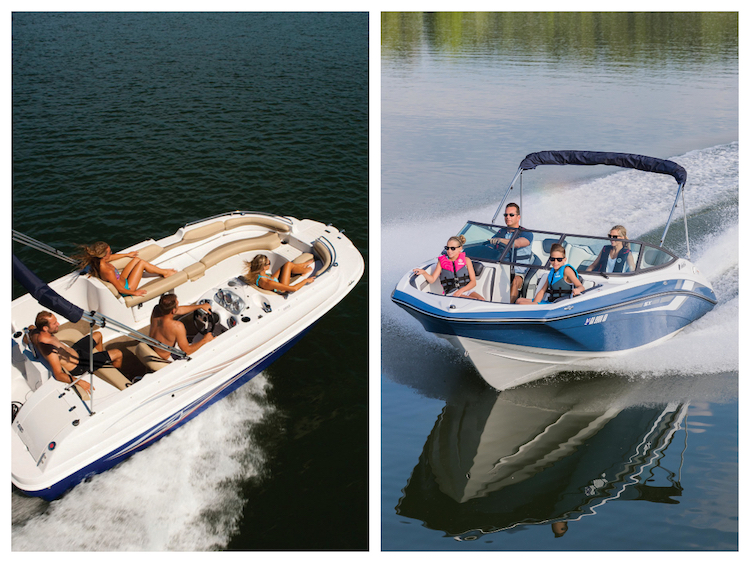Many people shopping for a family-friendly runabout get stuck on the bowrider vs deck boat debate. Both are popular boats for lakes, rivers, and coastal day cruising, yet they shine in different ways. Use this guide to compare performance, size, capacity, function, and hull design so you can choose one of these boat types with confidence.

What is a Bowrider?
A bowrider is a runabout with open bow seating in front of the helm. Think sporty handling with a social layout. The layout resembles a small sports boat with extra forward seating. If you're browsing bowrider boats for sale, you'll see boats typically focused on performance and style with a comfortable cockpit.
Bowrider basics:
- Purpose: Fun, fast day cruising, tubing, and light watersports.
- Length: Typically 17-27 feet.
- Layout: U or V-shaped bow area with lounge seats; cockpit with helm and co-pilot seats; aft bench; integrated swim platform.
- Engines: Outboard, inboard, or stern drive; some models use jet drive.
- Best For: Protected waters, quick trips, easy trailering.
What is a Deck Boat?
A deck boat stretches the beam forward to create a wider bow area, giving you more space without jumping up drastically in length. The silhouette resembles a hybrid of a runabout and a pontoon. It's open, roomy, and easy to board.
Deck boat basics:
- Purpose: Maximum cockpit space for groups, sandbar days, and cruising with kids.
- Length: Usually 18-26 feet.
- Layout: Squared-off, beamy bow with wraparound seating; roomy cockpit; aft bench; large swim platform.
- Engines: Mostly outboards, with some stern drive options depending on brand.
- Best for: Social gatherings, coves, and relaxed trips where capacity and comfort matter most.
Key Differences at a Glance
1. Size and Capacity
If you host larger crews, deck boats offer more usable square footage in the same trailerable footprint.
- Bowrider: Narrower forward section; seats 6-10 depending on length. Storage is good but not excessive.
- Deck boat: Wider beam carried forward; seats 8-12 in similar lengths. Big under-seat storage and generous walk-through space.
2. Hull Design and Ride
A bowrider's deeper V-shaped hull can provide a softer ride in rough water for comparable sizes. A deck boat's added buoyancy forward helps with stability when beached or anchored.
- Bowrider: Deeper V-shape and sporty hull design on many models; agile, quick to plane.
- Deck boat: Modified-V or hybrid hull shapes with extra beam forward. Excellent stability at rest and while loading passengers.
3. Performance and Handling
- Bowrider: Crisp cornering and lively throttle response. Popular with watersport enthusiasts who like slalom, kneeboarding, and wake toys.
- Deck boat: Solid cruising speeds with predictable handling. Not as razor-sharp in turns as a sport-focused bowrider, but very comfortable for family runs.
4. Function and Features
Here's how layout and onboard amenities differ between bowriders and deck boats, and what that means for day-to-day use.
Bowrider:
- Sport seating with bolster-style helm chairs
- Compact head options on larger models
- Transom walk-through to the swim platform
- Clean, athletic styling
Deck boat:
- Expanded bow seating with room for coolers and tables
- Frequent head compartment availability even at modest lengths
- Boarding doors and beach-friendly ladders
- Entertaining add-ons (cockpit tables, galley modules)
5. Power Options: Outboard vs. inboard vs. Stern Drive
Outboards free up cockpit space, tilt fully for shallow water, and are easy to service. While a stern drive keeps the transom open and low for watersports, it also provides a sleek look. Inboards and jet drives are typically found on sportier or specialty models.
- Bowrider: Found with outboard, inboard, and stern drive setups; some performance variants use jet drive.
- Deck boat: Heavily outboard today; a few brands still offer stern drive.
6. Storage and Access
Storage and ease of getting on and off the boat impact every outing.
- Bowrider: Ski lockers, under-seat compartments, and a transom trunk are available on some models.
- Deck boat: Extra-wide seats translate to bigger compartments; easy in-and-out via broad bow steps and large aft platforms.
7. Trailering and Ownership
Both are trailer-friendly, ranging from 18 to 24 feet.
- Bowrider: Slightly lighter at the same length; sporty towing manners.
- Deck boat: Similar tow class, but the wider forward beam may add windage. The payoff is room at the sandbar.
Pro Tips for Boat Shopping
Choosing between a bowrider and a deck boat starts with how you like to spend time on the water. If you lean sporty and want a classic runabout feel with crisp handling, a bowrider often fits that personality. If you prioritize an open, social layout with extra room, a deck boat tends to deliver more usable space at a similar length.
Choose a bowrider if you want:
- Sporty handling and quick acceleration
- A sleek runabout feel for day cruising.
- Strong crossover potential for towing tubes and light boards
- Options across outboard, inboard, stern drive, and jet drive
Choose a deck boat if you want:
- Maximum space for families, friends, and gear
- An easy social layout with a generous bow area
- Frequent head compartment availability in mid sizes
- Stable loading, beaching, and at-anchor comfort
Both boats offer an excellent choice for active families. In practice, bowriders lean sport; deck boats lean space.
Deck Boat vs. Bowrider: Which Is Best?
Both deck boats and bowriders are proven, popular boats for family fun. If space and socializing are at the top of your wish list, a deck boat stands out. If you value punchy handling and a classic sport runabout look, a bowrider hits the mark.
Good luck with your boat shopping journey! For more assistance, be sure to visit our Boat Finder.

